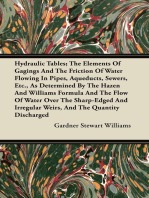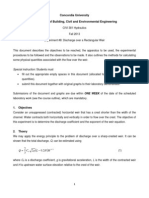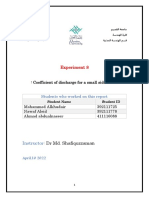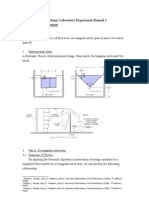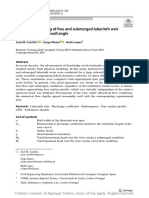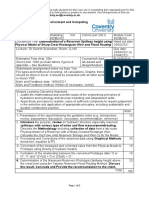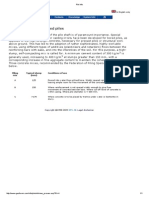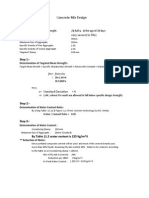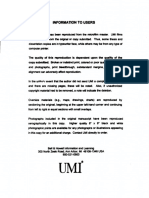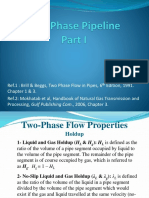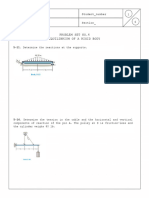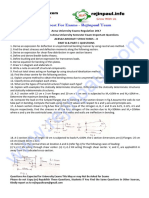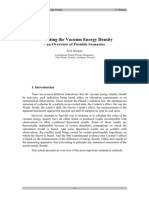Broad Crested Weir Module-3
Broad Crested Weir Module-3
Uploaded by
Arvin BhurtunCopyright:
Available Formats
Broad Crested Weir Module-3
Broad Crested Weir Module-3
Uploaded by
Arvin BhurtunOriginal Description:
Copyright
Available Formats
Share this document
Did you find this document useful?
Is this content inappropriate?
Copyright:
Available Formats
Broad Crested Weir Module-3
Broad Crested Weir Module-3
Uploaded by
Arvin BhurtunCopyright:
Available Formats
The University of Alabama Department of Civil, Construction and Environmental Engineering
Water Resources Engineering Laboratory Flow Over a Broad Crested Weir Author Humberto Avila(PhD)
FLOW OVER A BROAD CRESTED WEIR Modified by Redahegn(Redi) Sileshi January, 2009 1. Outcomes 2. 3. Conduct various civil engineering experiments related to the course, analyze and evaluate the results with regard to real application. Write a well organized work report with good verbal, graphical content.
Objectives: Understand the flow patterns over a broad-crested weir. Use the equation that quantifies the discharge over a broad-crested weir and be familiar with the equation by taking various values for the parameters in the equation. Determine the discharge coefficient Cd on a broad-crested weir using the given parameters. Analyze and discuss the results. Theory
Weirs are elevated hydraulic structures used to measure flow and/or control the water elevation at outflows from basins and channels [1]. Broad-crested weirs operate under the theory that critical flow conditions are created above the weir [1]. That means that the depth of water above the weir is equivalent to the critical depth (yc). Critical condition is obtained when the relationship between the inertial forces and the gravitational forces of the flow is equal to 1.0; therefore, the velocity of the flow, V, is equal to the velocity of the wave (or celerity), c = is known as Froude number (F). F=1 when the flow is critical.
gy ;. This relationship
F=
V gy
(1)
where, V= average velocity of the flow (m/s) y = depth of water (m). y becomes yc if critical flow is present. g = Gravity (m/s2) Figure 1 shows the profile on a broad-crested weir.
The University of Alabama Department of Civil, Construction and Environmental Engineering
Water Resources Engineering Laboratory Flow Over a Broad Crested Weir Author Humberto Avila(PhD)
EGL
V2/2g h1
yc yo P Air cavity Broad Crested Weir
HT FLOW
Figure 1: Profile on a broad-crested weir with rounded entrance transition [2]
The following equation represents the actual flow rate over a broad-crested weir,
Q = Cd
2 g b H 3
3/ 2
= C d 1.705 b H 3 / 2
(2)
where, Q = Actual flowrate (m3/s) Cd = Discharge Coefficient g = Gravity (m/s2) b = Breadth of weir (m). b = 0.076 m (3 in) yo = upstream water depth (m) yc = critical depth (m). In this case is the depth relative to the top of the weir. h1 = Upstream head relative to the top of the broad-crested weir (m). H = Total energy head (m) of upstream flow measured relative to the weir-crest elevation.
H = h1 +
Vo . 2g Vo 2g
2
HT = Total energy head (m) of upstream flow measured relative to the base of the flume (m).
H T = yo +
Vo= average upstream velocity (m/s). Vo =Q/Ao P = Broad-crested weir height (m) In real application it is more convenient to use h1 in the equation instead of H. Therefore, the equation 2 is affected by a coefficient of velocity, Cv .[4].
Q = Cd Cv
2 g b h1 3
3/ 2
= C d C v 1.705 b h1
3/ 2
(3)
Finally, a proper operation of a broad-crested weir is achieved when flow conditions are restricted to an operation range of 0.08< h1/L <0.33, (French, 1985) [1]; where L is the length of the weir (m). 4. Experimental Procedure
The experiment has the following procedure: � The broad-crested weir will be installed in the flume, which has to be leveled. 2
The University of Alabama Department of Civil, Construction and Environmental Engineering
Water Resources Engineering Laboratory Flow Over a Broad Crested Weir Author Humberto Avila(PhD)
� � �
One vernier is located upstream of the weir and the zero is set up with the base of the flume. This vernier will measure yo. The other vernier is located in the center of the broad-crested weir and the zero is set up with the top of the weir surface. This vernier will measure yc. Set the initial flowrate at 0.5 L/s (approximately) and determine both the upstream water depth and the depth on the weir (critical depth). Determine the accurate flowrate using the volumetric indicator and the stop watch. Increase the flowrate by increments of 0.2 L/s and repeat the measures until it get to 2.1 L/s. This means that (8) runs are required. Make sure that you are taking precise flowrate measurement when you do volumetric indicator and the stop watch. Use the following tables as guide to record the experimental data.
� �
Experimental data
Trial Volume (L) Time (sec) Flowrate (L/s) Flowrate 3 (m /s) Upstream head (mm) Critical depth (mm)
1 2 3 4 5 6 7 8 5. � � � � � � Calculations Calculate Vo, h1, and H for each trial. Calculate Cd for each trial using the equation 2. Calculate Cv for each trial using the equation 3. Calculate the Froude number for each trial using the yc (depth on the weir-crest elevation) and the equation 1. Calculate the relationship h1/L for each trial. Analyze the results.
6. � � � � � �
Analysis and discussion of the results Does your result for h1/L is within the operational range explained above. Comment on the results makes your own engineering guess if your result does exist in the limit. Give your own Comment on the Froude numbers calculated at the broad crested weir. Does the magnitude of the flow rate affect the discharge coefficient Cd? if you say yes/no give your own explanation for your answer. Does Cd increase or decrease with increasing flow rate? if you say yes/no give your own explanation for your answer. What is the pattern of the water as it passes over the weir? Does the magnitude of the flow rate affect the coefficient velocity Cv? if you say yes/no give your own explanation for your answer.
The University of Alabama Department of Civil, Construction and Environmental Engineering
Water Resources Engineering Laboratory Flow Over a Broad Crested Weir Author Humberto Avila(PhD)
� �
Does Cv increase or decrease with increasing flow rate? if you say yes/no give your own explanation for your answer. Would you expect the length of the weir crest to affect the discharge coefficient Cd and the operation of the weir? Explain.
7.
Content of the report
submit a formal report before/by next class. The report should cover the following: � � Introduction and objectives Theory: definition and/or description of the hydraulic structure, equations and explanation of the variables, examples about in which cases the hydraulic structure is used, explanation of the Froude number and its types of flow conditions. Sources should also be included. Experimental procedure Experimental data Calculations: Explain in detail the procedure and include the Excel tables. Analysis and discussion of results References References used for this guide [1] Chin, D.A. Water Resources Engineering, 2nd edition, Prentice Hall, 2006. [2] Sutley, David. An Instruction Manual of Open Channel Hydraulic Experiments for Water Resources Engineering. Thesis. The University of Alabama, 2005. [3] Mays, Larry. Hydraulic Design Handbook, McGraw Hill. New York. 1999. [4] Armfield, Instruction Manual for C4 Multi Purpose Teaching Flume. [5] Humberto Avila. Water Resources Engineering laboratory files for Open Channel Hydraulic Experiments . The University of Alabama, 2006-2007.
� � � � � 8.
You might also like
- Hydraulic Tables; The Elements Of Gagings And The Friction Of Water Flowing In Pipes, Aqueducts, Sewers, Etc., As Determined By The Hazen And Williams Formula And The Flow Of Water Over The Sharp-Edged And Irregular Weirs, And The Quantity DischargedFrom EverandHydraulic Tables; The Elements Of Gagings And The Friction Of Water Flowing In Pipes, Aqueducts, Sewers, Etc., As Determined By The Hazen And Williams Formula And The Flow Of Water Over The Sharp-Edged And Irregular Weirs, And The Quantity DischargedNo ratings yet
- Broad Crested Weir Module-3Document4 pagesBroad Crested Weir Module-3nidhalsaadaNo ratings yet
- Sharp Crested WeirDocument4 pagesSharp Crested WeirRamizah AhmadNo ratings yet
- Sluice Gate Module-6Document4 pagesSluice Gate Module-6CHEL TAK50% (2)
- Flow of Water by Notch and WeirsDocument17 pagesFlow of Water by Notch and WeirsMuhammad Zulhusni Che RazaliNo ratings yet
- Flow Over A Dam SpillwayDocument3 pagesFlow Over A Dam SpillwayIjaz MuhammedhNo ratings yet
- 4.experiment No 4 - Broad Crested WeirDocument19 pages4.experiment No 4 - Broad Crested WeirMd Sajedul Islam SetuNo ratings yet
- 3) Cut Throat FlumeDocument19 pages3) Cut Throat FlumeMd Sajedul Islam SetuNo ratings yet
- Fluid Lab WeirDocument10 pagesFluid Lab WeirlawanNo ratings yet
- Broad Crested WeirDocument7 pagesBroad Crested Weirrancid100% (1)
- Sluice Gate Module-6Document4 pagesSluice Gate Module-6hemontoyNo ratings yet
- Flow Over A Broad-Crested Weir in Subcritical Flow Conditions, Physical StudyDocument6 pagesFlow Over A Broad-Crested Weir in Subcritical Flow Conditions, Physical Studyho_afsharNo ratings yet
- WRE 404 Lab - Lec1 To Lec6Document22 pagesWRE 404 Lab - Lec1 To Lec6ShahAfzalSakiNo ratings yet
- Labyrinth WierDocument5 pagesLabyrinth Wiershefali1501No ratings yet
- Flow of Water by Notch and WeirsDocument15 pagesFlow of Water by Notch and WeirsCik Tiem Ngagiman93% (29)
- CIVI381 Lab Manual For Exp 8Document3 pagesCIVI381 Lab Manual For Exp 8Amandeep SinghNo ratings yet
- Flow Over A Broad-Crested Weir Exp4Document10 pagesFlow Over A Broad-Crested Weir Exp4Ahmad Ismail91% (11)
- Report 7 CE231 Real OneDocument10 pagesReport 7 CE231 Real OneMohammed KhalidNo ratings yet
- Broad Crested WeirDocument16 pagesBroad Crested WeirBenson Mwathi Mungai67% (3)
- Experimental Study For Sequent Depth Ratio of Hydraulic Jump in Horizontal Expanding ChannelDocument9 pagesExperimental Study For Sequent Depth Ratio of Hydraulic Jump in Horizontal Expanding ChannelAtiqur Rahman MishuNo ratings yet
- Momentra-Laboratory ProposalDocument8 pagesMomentra-Laboratory ProposalJULLIANA KEI PINONo ratings yet
- Anti-Clogging Drip Irrigation Emitter Design Innovation: Ali Abdulqader Mohammed AliDocument11 pagesAnti-Clogging Drip Irrigation Emitter Design Innovation: Ali Abdulqader Mohammed AliVijay ChavanNo ratings yet
- V NotchDocument21 pagesV NotchBenson Mwathi Mungai67% (3)
- Storm Sewer Hydraulic Calculations With The Manning Equation - Engineering Excel SpreadsheetsDocument3 pagesStorm Sewer Hydraulic Calculations With The Manning Equation - Engineering Excel Spreadsheetsttplan800No ratings yet
- Flow of Water by Notch and WeirsDocument15 pagesFlow of Water by Notch and WeirsAngelica Joyce BenitoNo ratings yet
- Lab-2: Flow Over A Weir Objectives: Water Resources Engineering Jagadish Torlapati, PHD Spring 2017Document4 pagesLab-2: Flow Over A Weir Objectives: Water Resources Engineering Jagadish Torlapati, PHD Spring 2017Katy PerryNo ratings yet
- Falling Head Permeability Lab TestDocument6 pagesFalling Head Permeability Lab TestHamierul MohamadNo ratings yet
- Proceding TeDocument7 pagesProceding TeAnonymous cncdtlNNo ratings yet
- Fluid Mechanics: Hydraulic BenchDocument11 pagesFluid Mechanics: Hydraulic BenchAmar Hafiz83% (6)
- 2022 PPT On OfficeDocument18 pages2022 PPT On OfficealemshetNo ratings yet
- Flow Over WeirsDocument13 pagesFlow Over WeirsAkmalhakim Zakaria100% (4)
- Falling Head Permeability - 011Document8 pagesFalling Head Permeability - 011Bee-thumb FairusNo ratings yet
- Hec Ras Training Day 2Document147 pagesHec Ras Training Day 2Qaxim ShahNo ratings yet
- Using Inverse Laplace Transform For The Solution of A Flood Routing ProblemDocument4 pagesUsing Inverse Laplace Transform For The Solution of A Flood Routing ProblemSudharsananPRSNo ratings yet
- Determining How To Calculate River Discharge: How Much Water Is Flowing in The River?Document15 pagesDetermining How To Calculate River Discharge: How Much Water Is Flowing in The River?EQ130% (1)
- Surface Roughness Effects On Discharge Coefficient of Broad Crested WeirDocument7 pagesSurface Roughness Effects On Discharge Coefficient of Broad Crested WeirAnbu KumarNo ratings yet
- Labyrinth Weir DesignDocument15 pagesLabyrinth Weir Designchutton681No ratings yet
- Civl 151 LAB2Document5 pagesCivl 151 LAB2Ong George SammyNo ratings yet
- Numerical Modeling of Free and Submerged LabyrinthDocument19 pagesNumerical Modeling of Free and Submerged LabyrinthRocio GarcíaNo ratings yet
- OrificeDocument7 pagesOrificePrasillaPrisiNo ratings yet
- Hydraulic Laboratory Civil Engineering Department Sultan Azlan Shah PolytechnicDocument12 pagesHydraulic Laboratory Civil Engineering Department Sultan Azlan Shah PolytechnicSyafiq Roslan75% (4)
- Flow Over WeirsDocument22 pagesFlow Over WeirsNurfayyadhahtul Syafawani100% (1)
- Department of Mechanical and Industrial TechnologyDocument20 pagesDepartment of Mechanical and Industrial TechnologyMPHILWENHLE JELENo ratings yet
- A3 (A) : Elements of Water Supply Network Design.: Pipe FlowDocument4 pagesA3 (A) : Elements of Water Supply Network Design.: Pipe Flowpradeep987No ratings yet
- FM230-Hydraulics Lab 2 2010 Small Rig ADLDocument12 pagesFM230-Hydraulics Lab 2 2010 Small Rig ADLAlex RepseviciusNo ratings yet
- Kajian Aliran Melalui Pelimpah Ambang Lebar Dan Pelimpah Ambang TipisDocument12 pagesKajian Aliran Melalui Pelimpah Ambang Lebar Dan Pelimpah Ambang TipisDarwin ChenNo ratings yet
- CIVL 2510 - LAB1 - Hydraulic JumpDocument7 pagesCIVL 2510 - LAB1 - Hydraulic JumpmaxNo ratings yet
- Flow Measurement With Long-Throated Flumes Under Uncertain SubmergenceDocument13 pagesFlow Measurement With Long-Throated Flumes Under Uncertain SubmergenceNgân Hàng Ngô Mạnh TiếnNo ratings yet
- Numerical Modeling of Free and Submerged Labyrinth Weir Flow For A Large Sidewall AngleDocument18 pagesNumerical Modeling of Free and Submerged Labyrinth Weir Flow For A Large Sidewall AnglesoniaNo ratings yet
- Hydraulics Report Micro2000 CEwebsiteDocument16 pagesHydraulics Report Micro2000 CEwebsiteKossaki JMNo ratings yet
- BNP 20103 Ex 3Document6 pagesBNP 20103 Ex 3aoi_chiepNo ratings yet
- Jomo Kenyatta University of Agriculture and TechnologyDocument19 pagesJomo Kenyatta University of Agriculture and TechnologyMohd Afiq AminNo ratings yet
- Flow Ovr WeirDocument9 pagesFlow Ovr WeirniasandiwaraNo ratings yet
- Faculty of Engineering Environment and Computing Assignment BriefDocument6 pagesFaculty of Engineering Environment and Computing Assignment Briefsantino paoliNo ratings yet
- Oxygen Transfer Model Development Based On Activated Sludge and Clean WaterDocument9 pagesOxygen Transfer Model Development Based On Activated Sludge and Clean WaterSol AngelNo ratings yet
- Southern Marine Engineering Desk Reference: Second Edition Volume IFrom EverandSouthern Marine Engineering Desk Reference: Second Edition Volume INo ratings yet
- A First Course in Dimensional Analysis: Simplifying Complex Phenomena Using Physical InsightFrom EverandA First Course in Dimensional Analysis: Simplifying Complex Phenomena Using Physical InsightNo ratings yet
- Wave and Tidal EnergyFrom EverandWave and Tidal EnergyDeborah GreavesNo ratings yet
- Technical Sheet: Residential RoadsDocument9 pagesTechnical Sheet: Residential RoadsArvin BhurtunNo ratings yet
- Pile InfoDocument1 pagePile InfoArvin BhurtunNo ratings yet
- Concrete Mix Design by ShoyeebDocument21 pagesConcrete Mix Design by ShoyeebbinoNo ratings yet
- Aggregate Properties SUMMARY: Lbs LbsDocument1 pageAggregate Properties SUMMARY: Lbs LbsArvin BhurtunNo ratings yet
- Communique - Japanese Govt (MEXT)Document3 pagesCommunique - Japanese Govt (MEXT)Arvin BhurtunNo ratings yet
- The Workers' Rights (Additional Remuneration) (2020) Regulations 2019Document2 pagesThe Workers' Rights (Additional Remuneration) (2020) Regulations 2019Arvin BhurtunNo ratings yet
- Legend: HospitalDocument1 pageLegend: HospitalArvin BhurtunNo ratings yet
- Concrete Mix DesignDocument13 pagesConcrete Mix DesignGurujawahar JadaproluNo ratings yet
- New Mauritius Hotels LTD: Installation and Operation of A Desalination Plant at Trou Aux Biches HotelDocument5 pagesNew Mauritius Hotels LTD: Installation and Operation of A Desalination Plant at Trou Aux Biches HotelArvin BhurtunNo ratings yet
- The Commencement Date Is The Start of TheDocument4 pagesThe Commencement Date Is The Start of TheArvin BhurtunNo ratings yet
- Ground Floor Plan of Residential BuildingDocument1 pageGround Floor Plan of Residential BuildingArvin BhurtunNo ratings yet
- The Commencement Date Is The Start of TheDocument4 pagesThe Commencement Date Is The Start of TheArvin BhurtunNo ratings yet
- 3-Bedroom Apartment Layout and SectionsDocument1 page3-Bedroom Apartment Layout and SectionsArvin BhurtunNo ratings yet
- Dimensions and Column Layout of Residential Building: LegendDocument1 pageDimensions and Column Layout of Residential Building: LegendArvin BhurtunNo ratings yet
- 3-Bedroom Apartment 2-Bedroom ApartmentDocument1 page3-Bedroom Apartment 2-Bedroom ApartmentArvin BhurtunNo ratings yet
- Arterial Road Section: All Dimensions Are in Meters Scale 1:100Document1 pageArterial Road Section: All Dimensions Are in Meters Scale 1:100Arvin BhurtunNo ratings yet
- 2-Bedroom Apartment Layout and SectionsDocument1 page2-Bedroom Apartment Layout and SectionsArvin BhurtunNo ratings yet
- Commencement, Delays & SupervisionsDocument3 pagesCommencement, Delays & SupervisionsArvin BhurtunNo ratings yet
- Street Sewer Layout: All Dimensions Are in Meters Scale 1:2000Document1 pageStreet Sewer Layout: All Dimensions Are in Meters Scale 1:2000Arvin BhurtunNo ratings yet
- 2-Bedroom Apartment Dimensions: All Dimensions Are in Meters Scale 1:100Document1 page2-Bedroom Apartment Dimensions: All Dimensions Are in Meters Scale 1:100Arvin BhurtunNo ratings yet
- List of BS CodesDocument33 pagesList of BS Codesnavaneethsparkwest100% (8)
- NewsHighs Apr12Wk3 (16-20)Document1 pageNewsHighs Apr12Wk3 (16-20)Arvin BhurtunNo ratings yet
- Datasheet - DK 3 - III CMES 25. Gas Diaphragm PumpDocument7 pagesDatasheet - DK 3 - III CMES 25. Gas Diaphragm Pumpnamdongvan8143No ratings yet
- Holography - Current and Future ApplicationsDocument4 pagesHolography - Current and Future ApplicationsJenny TaylorNo ratings yet
- Physics Brawl TSTDocument5 pagesPhysics Brawl TSTFaith FrancisNo ratings yet
- Mauricio 2018Document31 pagesMauricio 2018Steph GruverNo ratings yet
- Stability Castelated BeamsDocument142 pagesStability Castelated BeamsLuiza Girelli ChitolinaNo ratings yet
- Training - Flowserve Apm Pump CW PumpDocument19 pagesTraining - Flowserve Apm Pump CW Pumphasan099100% (1)
- 30 Level Timber Building PDFDocument5 pages30 Level Timber Building PDFalberto5791No ratings yet
- 화공열역학 ch2 솔루션Document137 pages화공열역학 ch2 솔루션na71663676No ratings yet
- Design of Stay Vanes and Spiral CasingDocument33 pagesDesign of Stay Vanes and Spiral CasingDaniel CoelhoNo ratings yet
- Lvem User Profile-Wesley SandersDocument3 pagesLvem User Profile-Wesley SandersCarlos Ovidio PalaciosNo ratings yet
- Highway II Chap 1Document29 pagesHighway II Chap 1Nahom EngIdaworkNo ratings yet
- Two Phase Flow in PipesDocument27 pagesTwo Phase Flow in PipesHassanKM100% (1)
- Hibbeler Chapetr 4 and 5 Practice ProblemDocument6 pagesHibbeler Chapetr 4 and 5 Practice ProblemKate Dela CruzNo ratings yet
- Equilibrium in 2&3DDocument30 pagesEquilibrium in 2&3Dpaulmwadime505No ratings yet
- 1st Year Chem Notes 2018 PDFDocument116 pages1st Year Chem Notes 2018 PDFMuhammad Kashif ZamanNo ratings yet
- Welding Dos Dont SDocument1 pageWelding Dos Dont SIkhwan HafizNo ratings yet
- FLUIDSDocument55 pagesFLUIDSMonville RedNo ratings yet
- DMV30193-CH 1Document10 pagesDMV30193-CH 1Rothiyah IshakNo ratings yet
- Chapter 3b Nonequilibrium Excess Carriers in SemiconductorsDocument25 pagesChapter 3b Nonequilibrium Excess Carriers in SemiconductorsVishalNo ratings yet
- Anna University Exams Regulation 2017 Ae8502 Aircraft Structures - Ii Part B & Part C QuestionsDocument1 pageAnna University Exams Regulation 2017 Ae8502 Aircraft Structures - Ii Part B & Part C QuestionsmuthugpalavesaNo ratings yet
- Mod 3 - 3.2 PDFDocument9 pagesMod 3 - 3.2 PDFPranjal DograNo ratings yet
- Kendriya Vidyalaya Sangathan Kolkata Region Pre-Board Examination 2020-21 Class - Xii Subject:PhysicsDocument7 pagesKendriya Vidyalaya Sangathan Kolkata Region Pre-Board Examination 2020-21 Class - Xii Subject:PhysicsShivankar PandeyNo ratings yet
- NGMA DesignDocument17 pagesNGMA DesignJames LawsNo ratings yet
- Hydraulics ManualDocument42 pagesHydraulics ManualJm Cayapas100% (2)
- Technical Information Huizhou Jincheng: Epoxy Resin 1201AB-1Document2 pagesTechnical Information Huizhou Jincheng: Epoxy Resin 1201AB-1yiraldyNo ratings yet
- Astm D70 D70M 21Document3 pagesAstm D70 D70M 21Angel AmayaNo ratings yet
- Building Site Measurements For Predicting Air Infiltration RatesDocument17 pagesBuilding Site Measurements For Predicting Air Infiltration RatesjeccoNo ratings yet
- Estimating The Vacuum Energy Density: - An Overview of Possible ScenariosDocument25 pagesEstimating The Vacuum Energy Density: - An Overview of Possible ScenariosAkshaya Kumar RathNo ratings yet
- 6 Skin EffectDocument11 pages6 Skin EffectBuriro HayatNo ratings yet
- Goulds Data Sheets & Performance CurvesDocument7 pagesGoulds Data Sheets & Performance CurvesAliZenatiNo ratings yet
